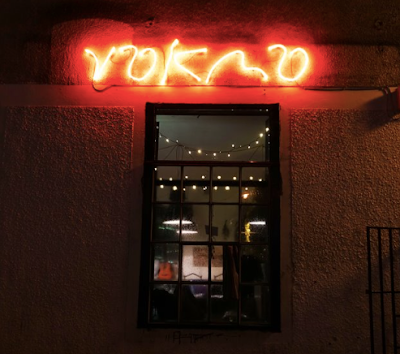Out of the window
Author:
Go to Source
 Here’s a language lesson: Máš vokno (pronounced mash vokno) is a colloquialism in Bohemia. It can be translated as ‘out of the window’ but usually means – ‘it’s somewhere in my head, but I can’t quite remember it.’
Here’s a language lesson: Máš vokno (pronounced mash vokno) is a colloquialism in Bohemia. It can be translated as ‘out of the window’ but usually means – ‘it’s somewhere in my head, but I can’t quite remember it.’Ever had that feeling? It’s often said by the Czechs when someone is a little worse for wear after too much alcohol. Me? I sometimes experience something similar when I’m sat in a boring lecture. In one ear – and out the other.
And that’s ironic. There’s a bar, and a very bohemian one at that, in the north west of the Czech Republic in a town called Liberec. The bar is actually called Vokno, and it’s somewhat spartan and minimal, with industrial overtones. It looks as though it’s a part of an old warehouse, and it’s down a backstreet, not easy to find. The exterior looks like it’s about to collapse. The interior isn’t much better. Some call it the worst bar in Liberec, while others flock there to hang out with the hipsters and the cool kids. I guess it depends on your perspective.
I was taken to Vokno by Czech radio host David Hamr, after a hard day recording a series of interviews at the studio (see this post). Everything about the place is alternative – the music, the drinks, the food, the decor….
None of the chairs and tables match, and looks like they’ve been begged, borrowed (or possibly stolen) from elsewhere. Anywhere. Some of the beers served at Vokno are curious – I swear the one I tried was gooseberry flavour. I must admit, I didn’t try the food on offer. I couldn’t decipher the menu. My host and I sat outside in the courtyard (you have to climb wooden steps up and then down the other side to reach it, because this looked like it was through a window instead of a door – a clue to the name perhaps), and we sat with various creative types who chatted in Czech, English, German and a smattering of other languages as appropriate.
 |
| Images from Bar Vokno |
The important thing to remember is that Vokno is a place to gather, to meet like minded people. It’s a venue where people share their ideas, create and generally spend time together relaxing while talking and thinking about life. Some of the bar tables look as though they are used for making and creating. In fact, parts of the seating area look more like a workshop than a bar (image left).
It’s name – window – is appropriate, because it is a window on another world. Just outside Vokno is a large city, where finance, manufacturing, commerce and industry are constantly in ebb and flow. One of the largest and shiniest shopping malls is only a stone throw away, and this is constructed of chrome, steel and glass.
Vokno, like so many other informal spaces, provides a place for gathering, for community life, for dialogue. This is the basis for much of what we learn, especially when we are adults and no longer in the formal schooling.
As Nick Shackleton-Jones remarked recently at his book launch – it’s a shame we don’t facilitate more conversational and relational learning in organisations. Instead, we create lectures, instructional texts and e-learning where conversation is removed completely from the process to be replaced mainly by content. Where is the dialogue in learning and development today? It’s no accident that many delegates often rate the social events and after conference sessions as the most valuable aspects of a conference. When we talk together, we learn from each other, and we argue and tell stories – all of which can be elements of rich learning experiences.
So what will we do with learning in our organisations in the future? Will we continue to produce so much content it overwhelms our participants? Or will we provide more authentic learning where we can discuss, converse and share. I don’t know about you, but many of my most memorable, and useful experiences of learning come from conversations. But with instruction and lectures it’s often a case of máš vokno.
